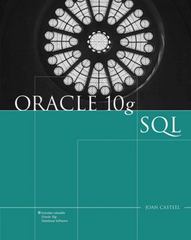Question
Objective: To program using the logic programming paradigm. Assignment: Download and install SWI-Prolog from http://www.swi-prolog.org/ Research Prolog features and programming style, then answer the 5
Objective:
To program using the logic programming paradigm.
Assignment:
Download and install SWI-Prolog from http://www.swi-prolog.org/
Research Prolog features and programming style, then answer the 5 questions below.
Brief Introduction to Prolog
Note: You will find more programming related information in the help file that comes up directly after you install SWI-Prolog.
Relations in Prolog
Prolog programs specify relationships among objects and properties of objects.
When we say, John owns the book, we are declaring the ownership relationship between two objects: John and the book.
When we ask, Does John own the book? we are trying to find out about a relationship.
Relationships can also rules such as:
Two people are sisters if they are both female and they have the same parents.
A rule allows us to find out about a relationship even if the relationship isnt explicitly stated as a fact.
A little more on being sisters
As usual in programming, you need to be a bit careful how you phrase things:
The following would be better:
A and B are sisters if
A and B are both female and they have the same father and they have the same mother and A is not the same as B
Programming in Prolog
Declare facts describing explicit relationships between objects and properties objects might have (e.g. Mary likes pizza, grass has color green)
Define rules defining implicit relationships between objects (e.g. the sister rule above) and/or rules defining implicit object properties (e.g. X is a parent if there is a Y such that Y is a child of X).
One then uses the system by:
Asking questions above relationships between objects, and/or about object properties (e.g. does Mary like pizza? is Joe a parent?)
Facts
Properties of objects or relationships between objects;
Dr Hecker lectures in course 3120, is written in Prolog as:
<>Notice that:
names of properties/relationships begin with lower case letters.
the relationship name appears as the first term
objects appear as comma-separated arguments within parentheses.
A period . must end a fact.
objects also begin with lower case letters. They also can begin with digits (like 3120), and can be strings of characters enclosed in quotes (as in reads(fred, War and Peace)).
lectures(hecker, 3120). is also called a predicate
Facts about a hypothetical computer science department:
% lectures(X, Y): person X lectures in course Y
lectures(hecker, 3120).
lectures(codd, 3311).
lectures(backus, 3021).
lectures(ritchie, 3201).
lectures(minsky, 3414).
lectures(codd, 3314).
% studies(X, Y): person X studies in course Y
studies(fred, 3020).
studies(jack, 3311).
studies(jill, 3314).
studies(jill, 3414).
studies(henry, 3414).
studies(henry, 3314).
%year(X, Y): person X is in year Y
year(fred, 1).
year(jack, 2).
year(jill, 2).
year(henry, 4).
Together, these facts form Prologs database.
Queries
Once we have a database of facts (and, soon, rules) we can ask questions about the stored information.
Suppose we want to know if Hecker lectures in course 3120. Load the above database into prolog and then ask:
?- lectures(hecker, 3120). true. ?- % | ?- is Prologs prompt output from Prolog hold down control & press D to leave Prolog |
Notice that:
In SWI Prolog, queries are terminated by a full stop.
To answer this query, Prolog consults its database to see if this is a known fact.
In example dialogues with Prolog, the text in green italics is what the user types.
Your Assignment:
1. Given the relations
father(X,Y) X is the father of Y mother(X, Y) X is the mother of Y female(X) X is female male(X ) X is male
Define prolog relations for the following:
a. sibling b. sister c. grandson d. descendant
Provide some facts for the father, mother, male, and female predicates and then test the entire thing using Prolog.
2. Write a Prolog relation remove(E,L,R) that is true if R is the list which results from removing one instance of E from list L. The relation is false if E isnt a member of L.
What are all of the answers to the following queries?
ask remove(a,[b,a,d,a],R).
ask remove(E,[b,a,d,a],R).
ask remove(E,L,[b,a,d]).
ask remove(p(X),[a,p(a),p(p(a)),p(p(p(a)))],R).
3. Write a Prolog relation subsequence(L1,L2) that is true if list L1 contains a subset of the elements of L2 in the same order.
How many different proofs are there for each of the following queries?
ask subsequence([a,d],[b,a,d,a]).
ask subsequence([b,a],[b,a,d,a]).
ask subsequence([X,Y],[b,a,d,a]).
ask subsequence(S,[b,a,d,a]).
Explain why there are that many.
4. Write a Prolog relation that returns a list containing the union of the elements of two given lists.
5. Write another relation (anything you want) that does something not performed above. Explain what your relation does.
Step by Step Solution
There are 3 Steps involved in it
Step: 1

Get Instant Access to Expert-Tailored Solutions
See step-by-step solutions with expert insights and AI powered tools for academic success
Step: 2

Step: 3

Ace Your Homework with AI
Get the answers you need in no time with our AI-driven, step-by-step assistance
Get Started


